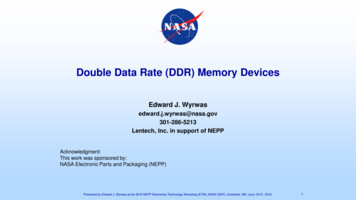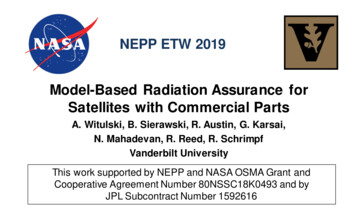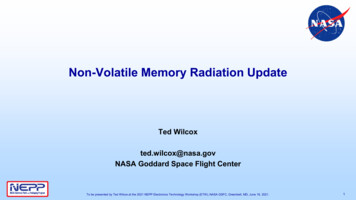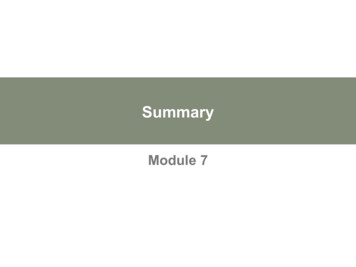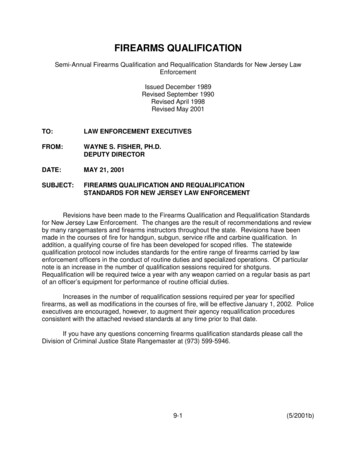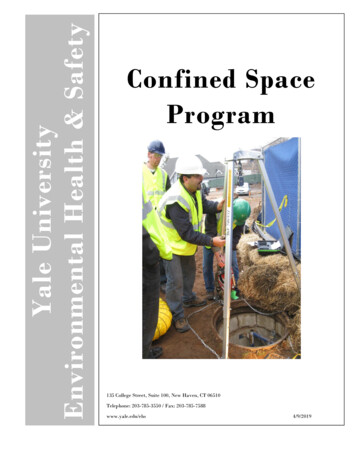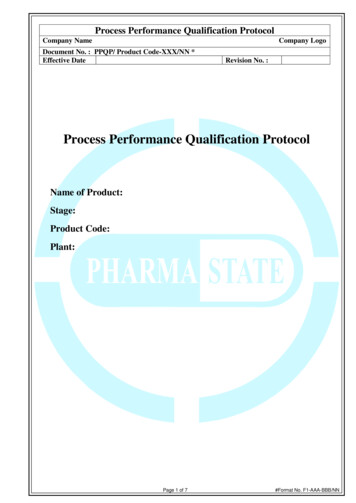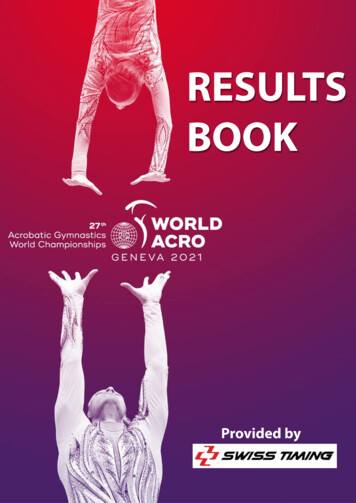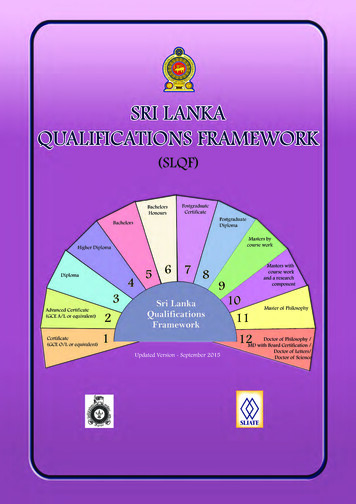
Transcription
Space Qualification of GaNHEMTs - Guidance DocumentAnnouncementJohn ScarpullaCaroline Gee20 June 2018NASA NEPP meeting 2018 The Aerospace Corporation
BackgroundHistory of some recent activities GaN HEMTs / MMICs have not yet been “officially” space qualified– A number of Class A & B missions have targeted GaN power HEMT technology forusage in the next few years– Exciting opportunities for applications such as SSPAs, High Intercept LNAs Existing techniques for accelerated testing and qual (as for GaAs) areinadequate:– GaN may not have a single dominant failure mode– Temperatures/voltages/power densities are generally much higher– DC stressing alone may not be sufficient In early 2017 an Aerospace draft document was written– ATR-2017-01782 “DRAFT – Guidelines for Space Qualification of GaN HEMTTechnology” J. Scarpulla & C. Gee, May 23, 2017 A working group was established to mature this document– 7 months of weekly meetings– Approx. 85 members / interested parties– Extensive edits and revisions were made based on many inputsDocument is now in release cycle: TOR-2018-00691 “Guidelines for SpaceQualification of GaN HEMT Technologies” J. Scarpulla, C. Gee2
Is GaN “different”?Well, yes We cannot qualify GaN devices in a similar way to previous III-Vsemiconductors (GaAs, InP)– Multiple failure mechanisms may exist– (they exist in GaAs too, but the lower voltages/currents/power levels preclude them)– Gate sinking no longer remains as dominant In our new document we focus on:– microwave/power HEMTs and MMICs Conventional Schottky gates No enhancement mode devices (very different physics) Typically (but not limited to) SiC substrates Qual methods– Intrinsic failure modes DC multi-temperature lifetests, at multiple bias points– Step-stress / constant stress RF-driven tests– CW / pulsed– TLYF (test like you fly)Multiple modes demand multiple tests3
Some Failure Mechanisms in GaN Power HEMTsGateSi3N4 liability Concerns:Gate diffusion, chemical reactionsSource/drain ohmic metal-semiconductor reactionsPits/cracks – moisture / mechanical stress (IPE**)Charging/traps- virtual gate (VG)Dislocation defects (throughout)Point defects (esp. at gate-drain edge)4*Source Connected Field Plate**Inverse Piezoelectric Effect***Two Dimensional Electron Gas
Stressing regimesDC stressing at four operating points (Q-points)Q1 hi poweras in JEP118 for GaAsOhmicQ2 hi current lo voltageQ3 hi voltage lo currentQ4 off stateReactions/defectsVirtual gateIPE 5Depending upon the RF load figure different failure modes are manifestedDevote at least two temperatures to each Q-point
Multiplicity of Intrinsic Failure ModesWith operation over different bias points DC lifetest data taken at operating point Q1– predicts EA 1.86eV, MTTF 5 106 hrs at mission temperature 250 C. CAVEATs:– Q2 - Q4 give much shorter MTTFs– A “sneak” low EA mechanism of 0.5eV could exist - short MTTFMedian Time to Fail, MTF (hours)1.E 07350 C 300200(mission)250150100 CQ1 1.86eVQ2 2.7eVQ3 1.4eVQ4 1.1eV1.E 060.5eV(sneak)15 yrs1.E 0551.E 04typical mission times11.E 031.E 021.522.531000/T [K]Guidelines are provided for comprehensive test campaigns6
Temperature Errors Affect Reliability PredictionsTemperatures are much higher in GaN power HEMTs Methods of temperature measurement – guidelines provided– IR thermography– Raman scattering Bulk - direct Surface – with nanoparticle sprinkling– Thermoreflectance– Gate end-end resistance measurement400 C1.E 08300250200Fixed T errors add1.E 061.E 051.E 05missions1.E 043502502001.E 041.E 031.E 03Lifetest data1.E 021.41.51.61.71.81.922.12.21.E 021.E 011.41.51.61000/T [K]Temperature errors have varied effects- guidelines are provided7300Rth errors cancel1.E 071.E 061.E 01400 C1.E 08TTF (hrs)TTF (hrs)1.E 07350– Translation from stress powerlevel to usage power level usingRth can introduce additionaltemperature errors and reliabilityprediction uncertainties1.71.81000/T [K]1.922.12.2
DefectsGuidance provided on reliability assessment of process defects Example – defects in MIMCAPs– MIMCAPs in GaN technology subjected to much higher voltage than in previous GaAstechnology – MIMCAPs may dominate failure ratesProbplot of rampedbreakdown voltagestransformationaverage failure rate, AFR (FITs)FIT rate vs. timeVm 40VTm 90 C8060w/ curve fitted defect densitiesw/interpolated defect densities40200012345678910 11 12 13 14 15mission time (years)Guidance provided on MIMCAP defect density testing and reliability prediction8
More Recommendations & Test ProtocolsTopics to consider for space qualification of GaN Robustness––––––– DC lifetesting (4 Q-points)RF lifetestingStep stressingTLYF (Test Like You Fly)Thin film resistorsElectromigrationEnvironmental Effects– Moisture sensitivity– Hydrogen sensitivity– Air SensitivityExtrinsic Defects–––– MIMCAPsGate DefectsAirbridge DefectsBackside Via defectsMechanical–––––Intrinsic Reliability–––––– SOA (safe operating area)Gate burnoutRF burnoutESDTemperature cyclingPower cyclingOff-state voltage screeningBackside metal adhesionBondpull testsDie shear testsStep CoverageLow Frequency OscillationsRadiation Effects––––Total Ionizing DoseDose RateSinge Event EffectsDisplacement DamageGuidelines are provided on these topics and more9
Conclusion A peer-reviewed and vetted space qualification methodology for GaN powerHEMTs and MMICs is now availableTOR-2018-00691 “Guidelines for Space Qualification of GaN HEMTTechnologies” J. Scarpulla, C. GeeFor more information please contact– john.scarpulla@aero.org– caroline.gee@aero.org 10THANK YOU!
Technology" J. Scarpulla & C. Gee, May 23, 2017 A working group was established to mature this document - 7 months of weekly meetings - Approx. 85 members / interested parties - Extensive edits and revisions were made based on many inputs Document is now in release cycle: TOR-2018-00691 "Guidelines for Space
